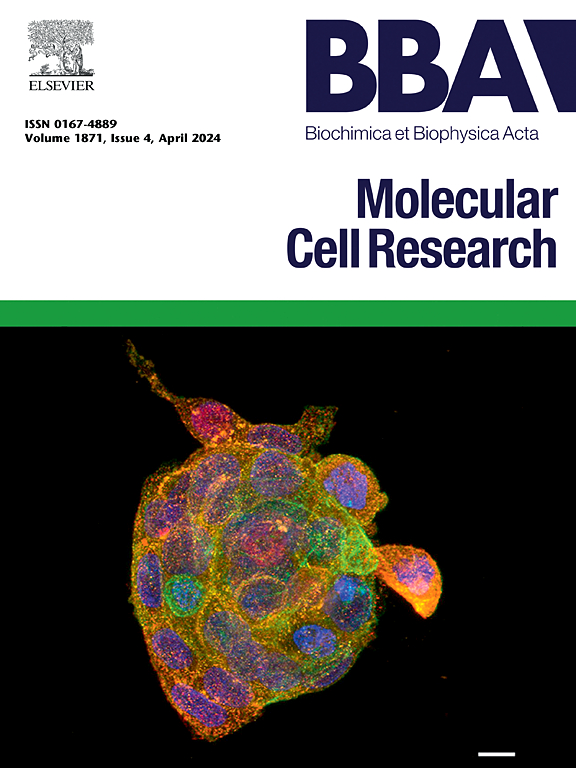细胞内钙诱导的ROS生成促进方碱光毒性。
IF 3.7
2区 生物学
Q1 BIOCHEMISTRY & MOLECULAR BIOLOGY
Biochimica et biophysica acta. Molecular cell research
Pub Date : 2025-08-30
DOI:10.1016/j.bbamcr.2025.120055
引用次数: 0
摘要
光动力疗法(PDT)是美国食品和药物管理局(FDA)批准的一种微创治疗方式,用于治疗包括癌症在内的几种病理状况。开发新型光敏剂是提高PDT治疗效果、减少副作用的重要途径。因此,更好地了解PS光激活引发的信号转导可能有助于优化PS的功效。在本工作中,我们合成了一系列具有不同吲哚胺环修饰的方胺类化合物。我们的研究结果表明,未取代的SQ具有显著的光毒性活性,并通过在吲哚环中引入一个溴(Br-SQ-C4)以及用硫原子取代方基氧原子(SQ- s - c4)进一步增强。光毒性与较高的光诱导细胞质Ca2+信号以及活性氧(ROS)的产生呈正相关。然而,不同的取代基强烈影响信号通路的触发。溴取代基加强了染料在内质网(ER)中的定位,而硫取代基将其优先定位转移到线粒体。一致地,Br-SQ-C4的光激活诱导更大的ER Ca2+释放,随后是SOCE,这促进了能够维持显着的线粒体Ca2+摄取和随后的线粒体ROS生成的二次ROS生成。另一方面,SQ-S-C4可以在基础水平上诱导Ca2+/ROS动力学的更大扰动。总的来说,我们的研究结果有助于更深入地了解SQs引发的细胞内信号传导,为开发旨在提高PDT疗效的新策略铺平道路。本文章由计算机程序翻译,如有差异,请以英文原文为准。
Intracellular calcium-induced ROS generation promotes squaraine phototoxicity
Photodynamic therapy (PDT) is a minimally invasive therapeutic modality approved by the Food and Drug Administration (FDA) for the treatment of several pathological conditions, including cancer. Developing new photosensitizers (PSs) for PDT is of great interest to increase the treatment efficacy while minimizing side effects. In this regard, a better understanding of the signal transduction triggered by PS photo-activation may help to optimize PS efficacy.
In the present work, we synthesized a series of squaraines (SQs) featuring different indolenine ring modifications. Our results show that unsubstituted SQ has significant phototoxic activity, further increased by the introduction of a bromine in the indolenine ring (Br-SQ-C4) as well as the replacement of the squaryl oxygen atoms with sulfur atoms (SQ-S-C4). Phototoxicity positively correlates with higher photo-induced cytoplasmic Ca2+ signals as well as reactive oxygen species (ROS) generation. However, the different substituents strongly affect the signaling pathway triggered. The bromine substituent strengthens the localization of the dye in the endoplasmic reticulum (ER), while the sulfur substituent shifts its preferential localization to the mitochondria. Consistently, photo-activation of Br-SQ-C4 induces a larger ER Ca2+ release followed by SOCE, which fuels secondary ROS generation able to sustain a remarkable mitochondrial Ca2+ uptake and subsequent mitochondrial ROS generation. On the other hand, SQ-S-C4 can induce, already at the basal level, a greater perturbation of the Ca2+/ROS dynamics.
Overall, our results contribute to a deeper understanding of the intracellular signaling triggered by SQs, paving the way for the development of novel strategies aimed at increasing PDT efficacy.
求助全文
通过发布文献求助,成功后即可免费获取论文全文。
去求助
来源期刊
CiteScore
10.00
自引率
2.00%
发文量
151
审稿时长
44 days
期刊介绍:
BBA Molecular Cell Research focuses on understanding the mechanisms of cellular processes at the molecular level. These include aspects of cellular signaling, signal transduction, cell cycle, apoptosis, intracellular trafficking, secretory and endocytic pathways, biogenesis of cell organelles, cytoskeletal structures, cellular interactions, cell/tissue differentiation and cellular enzymology. Also included are studies at the interface between Cell Biology and Biophysics which apply for example novel imaging methods for characterizing cellular processes.

 求助内容:
求助内容: 应助结果提醒方式:
应助结果提醒方式:


